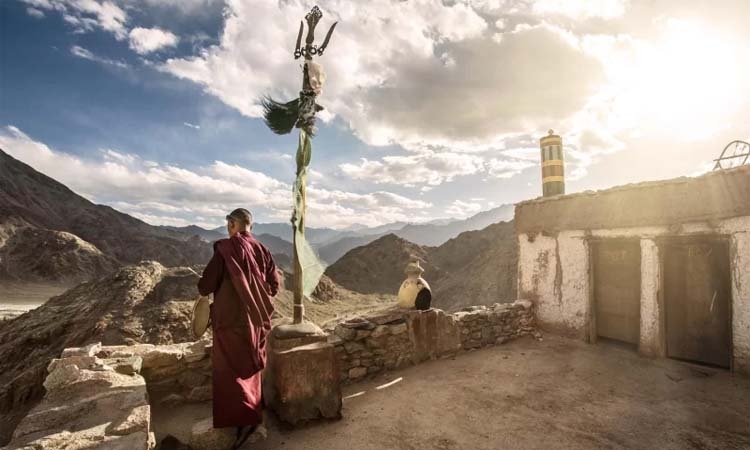Published: 07:48 PM, 18 March 2023
Buddhist Philosophy and Teachings: Exploring Diverse Approaches in the Indian Himalayas

The Indian Himalayas have been a melting pot of diverse religious traditions for centuries. The region has been a hub for spiritual seekers and religious practitioners, attracting a plethora of religious figures over time.
Among them, Padmasambhava and Gö Tsangpa are two of the most significant religious figures who have had a profound impact on the Buddhist philosophy and teachings, and the religious landscape of the Indian Himalayas.
Padmasambhava, also known as Guru Rinpoche, is widely regarded as the founder of Tibetan Buddhism. He was a spiritual master from India who lived during the 8th century CE.
Padmasambhava, also known as Guru Rinpoche, is widely regarded as the founder of Tibetan Buddhism. He was a spiritual master from India who lived during the 8th century CE.
Padmasambhava is credited with spreading Buddhism in Tibet, India, Bhutan, and Nepal. He is revered as a great teacher, healer, and protector by many followers of Tibetan Buddhism.
Gö Tsangpa, on the other hand, was a 14th-century Tibetan Buddhist master who spent a considerable amount of time in the Indian Himalayas.
Gö Tsangpa, on the other hand, was a 14th-century Tibetan Buddhist master who spent a considerable amount of time in the Indian Himalayas.
Gö Tsangpa is known for his contributions to the development of the Drukpa Kagyu school of Tibetan Buddhism. He established several monasteries and meditation practice centres in the Indian Himalayas, including the famous Hemis Monastery in Ladakh.
While Padmasambhava and Gö Tsangpa were both instrumental in the spread and development of Buddhism in the Indian Himalayas, their approaches to religious patronage were quite different.
While Padmasambhava and Gö Tsangpa were both instrumental in the spread and development of Buddhism in the Indian Himalayas, their approaches to religious patronage were quite different.
Padmasambhava’s approach was characterized by a more decentralized and flexible model of religious patronage. He encouraged the establishment of small, community-based monasteries that were supported by local patrons.
Padmasambhava’s approach to religious patronage can be seen in the way he established monasteries and meditation practice centres in the region.
Padmasambhava’s approach to religious patronage can be seen in the way he established monasteries and meditation practice centres in the region.
He did not emphasize the establishment of large monasteries or centralized institutions. Instead, he encouraged the establishment of smaller, community-based monasteries that were supported by local patrons.
This approach allowed for greater flexibility and adaptability to the needs of the local communities. For example, in Bhutan, Padmasambhava established the famous Paro Taktsang monastery, also known as the Tiger’s Nest monastery.
This monastery was built on a cliffside, and it is one of the most iconic religious sites in Bhutan. The monastery was not a large institution but rather a small, community-based monastery that served the needs of the local community.
The monastery was supported by local patrons, who provided the necessary resources to maintain the monastery. Gö Tsangpa, on the other hand, followed a more centralized and hierarchical model of religious patronage.
He established large monasteries and meditation practice centres that were supported by wealthy patrons and benefactors. This approach allowed for greater institutionalization of Buddhism in the region and facilitated the development of a distinct monastic tradition.
One example of Gö Tsangpa’s approach to religious patronage can be seen in the establishment of the Hemis Monastery in Ladakh. Hemis Monastery is one of the largest and wealthiest monasteries in the region, and it is home to a large community of monks.
One example of Gö Tsangpa’s approach to religious patronage can be seen in the establishment of the Hemis Monastery in Ladakh. Hemis Monastery is one of the largest and wealthiest monasteries in the region, and it is home to a large community of monks.
The monastery was established by Gö Tsangpa and was supported by wealthy patrons and benefactors. This approach allowed for the establishment of a centralized institution that could serve the needs of the larger community.
Despite their differing approaches to religious patronage, Padmasambhava and Gö Tsangpa both made significant contributions to the development of Buddhism in the Indian Himalayas. Their teachings and practices continue to influence the spiritual and religious traditions of the region to this day.
The religious patronage models of Padmasambhava and Gö Tsangpa offer important insights into the development of Buddhism in the Indian Himalayas and also Bhutanese Buddhism. While Padmasambhava’s approach emphasized decentralization and community-based patronage,
Despite their differing approaches to religious patronage, Padmasambhava and Gö Tsangpa both made significant contributions to the development of Buddhism in the Indian Himalayas. Their teachings and practices continue to influence the spiritual and religious traditions of the region to this day.
The religious patronage models of Padmasambhava and Gö Tsangpa offer important insights into the development of Buddhism in the Indian Himalayas and also Bhutanese Buddhism. While Padmasambhava’s approach emphasized decentralization and community-based patronage,
Gö Tsangpa’s approach was more centralized and hierarchical. Both models were successful in their own ways and contributed to the development of a rich and diverse religious landscape in the Indian Himalayas.
>> Source: The Bhutan Live
>> Source: The Bhutan Live




